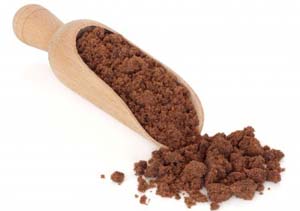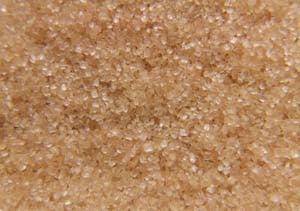I was recently asked what could be used as a brown sugar substitute. Because of this request and my long overdue task of adding additions to my substitutions category, I’ve decided to address this in depth. If you’re looking for a brown sugar that is refined, slightly refined, or unrefined, I list and explain the different varieties below, as well as provide a recipe for a brown sugar substitute. I hope this helps you when you’re in a pinch, as well as enlightens you on the manufacturing process and health benefits.
This article is available to everyone!
Brown Sugar
Light vs. Dark Brown Sugar
To make brown sugar they add molasses from unrefined or refined cane sugar. The only difference between light and dark brown sugar is their molasses content – dark brown sugar contains more. It can be found in refined and unrefined forms, though when refined, it is less refined than cane sugar.
Turbinado Sugar
In the United States, turbinado sugar is often used as a substitute for cane sugar because it is processed less. Though its flavor is a bit different than white cane sugar, it sweetens almost the same, as their sugar contents are almost identical. Turbinado sugar is the form of sugar our earlier generations used. It’s light brown color is achieved by washing in a machine that separates the liquid from the solids, allowing the molasses content to surface and then dried. The crystals are much larger than those found in brown sugar.
Muscovado Sugar
Muscovado Sugar is an unrefined or slightly processed, dark chocolate brown in color, and is also known as as raw sugar. In Asia and Europe it known as the poor man’s sugar because of the higher cost in processing cane sugar. It is moist, just like brown sugar; contains a higher amount of molasses than brown sugar; and is more coarse. You should check with each manufacturer, as a few are known to add processed cane sugar to their muscovado sugar. When unrefined, it is preferred by those concerned for their health, as it retains some of the vitamins and minerals that are lost during the process of cane sugar, and without all of the added chemicals. Muscovado sugar is derived from sugar cane. The sugar cane is chopped and pressed and the juices are extracted. The juice may be slightly heated, therefore, some are partially refined, while are others are unrefined. Some makers add lime, coconut milk and/or other acidic ingredients to prevent foam from forming during the heating process. It is then dried in the sun and broken into crystals. Muscovado sugar is made on the island of Barbados in the Caribbean, in the Philippines, and more.
Demerara Sugar
Demerara sugar is well known in the UK as a natural brown sugar. Demerara sugar is made the same as muscovado sugar, except demerara sugar may be made in several different locations. It is named after the colony in South America which produced it, formerly called Demerara, now known as Guyana.
Coconut Palm Sugar
Palm sugar, coconut sugar, coconut palm sugar…they’re all the same. It is derived from the flowers which grow on coconut trees. The flowers are opened and their nectars are collected, then air-dried into crystals. The natural brown color shows the richness of nutrients and phytonutrients (naturally occurring nutrients found in fruits, vegetables, grains, legumes, nuts, and teas), including potassium, zinc, iron, and vitamins B1, B2, B3 and B6. Read about all the nutrients in palm sugar. It is similar to brown sugar, but with a caramel flavor. It has a lower glycemic index than cane sugar, yet when used in cooking and baking, reacts just like sugar.
A Quick Brown Sugar Substitute
When you’re in the middle of baking and you realize that you’re low or out of brown sugar, you may mix 1 cup of cane sugar, or the natural sugar of your choosing with 1/4 cup of molasses, and reduce the liquid in the recipe by about 2 1/2 tablespoons. If you don’t have any brown sugar on hand, you may use any granulated sugar, cup for cup, as a substitution, though the flavor will change a bit. I’ve even known people to use sugar substitutes such as xylitol (birch derived is best), and those chemical filled artificial sweeteners. If I were to go the sugar-free route, I’d use “light” molasses with a bit of stevia, or birch derived xylitol (if you can tolerate anything ending in “lol”. There’s a reason why the raw and vegan community use stevia.
Why do Vegans and Vegetarians Avoid Cane Sugar
Perhaps you’ve wondered why vegetarians and vegans do not consume white cane sugar, but a natural or brown sugar substitute. To filter out the brown color of true cane sugar, the manufacturer may use bone char from cows, thus the animal connection. However, if carbon is used to remove the color from the sugarcane or sugar beets, it is safe for vegans to consume.
I hope this helps some.
Happy gluten free cooking!







I haven’t bought any brown sugar in a long time because I find the store bought version overpriced when I know that I can easily make my own delicious dark brown sugar with molasses and white sugar. However, I have seen palm sugar cakes at an Asian store and was wondering whether those could be ground somehow to have a sugar with a lower glycemic index and to try the caramelly flavor that is mentioned so often. They do seem pretty hard. Unfortunately, I did not see any granulated version at that store.